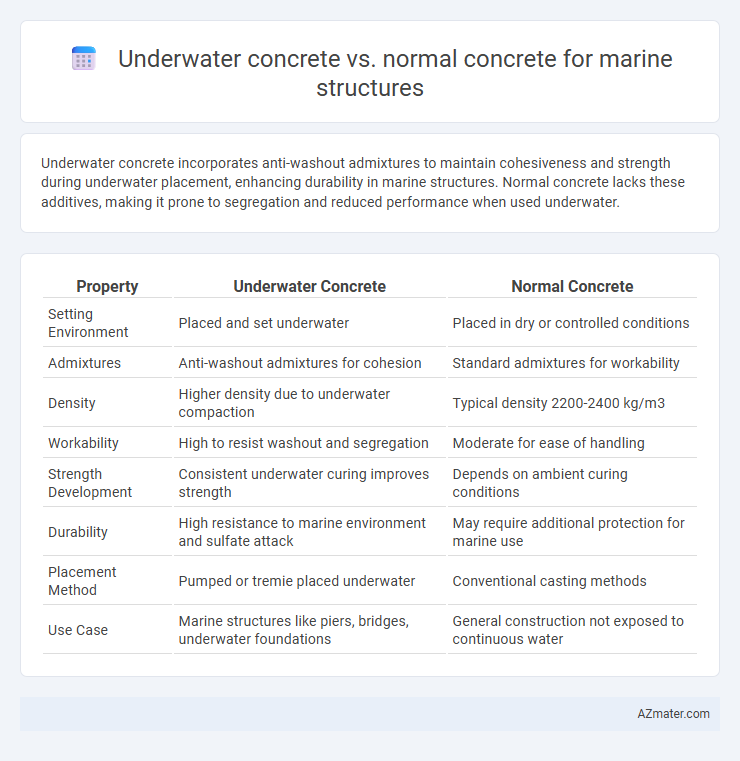Underwater concrete incorporates anti-washout admixtures to maintain cohesiveness and strength during underwater placement, enhancing durability in marine structures. Normal concrete lacks these additives, making it prone to segregation and reduced performance when used underwater.
Table of Comparison
| Property | Underwater Concrete | Normal Concrete |
|---|---|---|
| Setting Environment | Placed and set underwater | Placed in dry or controlled conditions |
| Admixtures | Anti-washout admixtures for cohesion | Standard admixtures for workability |
| Density | Higher density due to underwater compaction | Typical density 2200-2400 kg/m3 |
| Workability | High to resist washout and segregation | Moderate for ease of handling |
| Strength Development | Consistent underwater curing improves strength | Depends on ambient curing conditions |
| Durability | High resistance to marine environment and sulfate attack | May require additional protection for marine use |
| Placement Method | Pumped or tremie placed underwater | Conventional casting methods |
| Use Case | Marine structures like piers, bridges, underwater foundations | General construction not exposed to continuous water |
Introduction to Concrete Types for Marine Structures
Underwater concrete is specifically formulated to set and harden in submerged conditions, utilizing anti-washout admixtures and higher cement content to maintain cohesiveness underwater. Normal concrete, commonly used in above-ground applications, typically lacks these modifications and is prone to washout and reduced strength when placed underwater. Marine structures rely on underwater concrete for durability, resistance to chloride ingress, and effective placement in challenging aquatic environments.
Key Properties of Underwater Concrete
Underwater concrete, designed specifically for marine structures, features enhanced properties such as high cohesiveness and anti-washout characteristics, preventing cement dispersion in water. Its mix includes specialized admixtures like anti-washout agents and superplasticizers to maintain workability and strength under submerged conditions. The concrete's durability and resistance to chloride ion penetration are critical for withstanding aggressive marine environments, offering superior performance compared to normal concrete.
Characteristics of Normal Concrete in Marine Environments
Normal concrete in marine environments exhibits lower resistance to chloride ion penetration compared to underwater concrete, leading to accelerated corrosion of reinforcing steel. Its permeability increases due to saltwater exposure, which can compromise structural durability and reduce lifespan in harsh marine conditions. Standard curing methods for normal concrete are less effective underwater, impacting strength development and long-term performance against aggressive marine elements.
Mix Design Differences: Underwater vs Normal Concrete
Underwater concrete mix design incorporates higher cement content and specialized admixtures like anti-washout agents to prevent cement leaching during placement, ensuring durability in marine environments. Normal concrete has a standard mix with lower water-cement ratios and no need for anti-washout additives, optimized for controlled, dry curing conditions. The inclusion of slag or fly ash in underwater concrete enhances sulfate resistance and reduces permeability, crucial for marine structure longevity compared to typical normal concrete mixes.
Workability and Placement Methods
Underwater concrete is specifically formulated to maintain workability and cohesion during underwater placement, utilizing anti-washout admixtures that prevent cement particles from dispersing in water, unlike normal concrete which can segregate and lose strength when placed underwater. Placement methods for underwater concrete often involve tremie pipes to ensure continuous, pressure-controlled deposition, minimizing contamination and washout, whereas normal concrete relies on traditional pouring or pumping techniques suitable for dry conditions. The enhanced workability of underwater concrete is critical for marine structures, ensuring durability and structural integrity in harsh aquatic environments.
Durability Against Marine Exposure
Underwater concrete exhibits enhanced durability against marine exposure due to its specialized composition that minimizes segregation and washout during underwater placement, ensuring a dense and impermeable matrix resistant to chloride ion penetration. Normal concrete often lacks this robustness, making it more susceptible to deterioration from sulfate attack, corrosion of reinforcement, and freeze-thaw cycles in marine environments. The use of anti-washout admixtures and optimized aggregate grading in underwater concrete significantly improves its resistance to chemical degradation and mechanical erosion compared to conventional concrete.
Strength and Performance Comparison
Underwater concrete exhibits enhanced strength and durability compared to normal concrete in marine structures due to its specialized mix design that reduces washout and improves cohesion underwater. Its high-performance additives and chemical admixtures ensure superior early strength gain and long-term resistance to chloride penetration and sulfate attack, crucial for harsh marine environments. Normal concrete, while suitable for above-ground applications, typically lacks the impermeability and robustness needed to withstand continuous exposure to seawater and hydrostatic pressure.
Resistance to Corrosion and Chemical Attack
Underwater concrete exhibits enhanced resistance to corrosion and chemical attack compared to normal concrete, owing to its specialized mix design with anti-washout admixtures that maintain cement hydration underwater. This type of concrete reduces permeability and prevents chloride ion penetration, critical for protecting steel reinforcement in marine structures from corrosion. Normal concrete lacks these properties, making it more susceptible to aggressive seawater conditions, leading to faster degradation and compromised structural integrity.
Typical Applications in Marine Construction
Underwater concrete is specially designed for pouring and setting in submerged conditions, making it ideal for marine structures such as bridge piers, offshore platforms, and harbor walls where water exposure is constant. Normal concrete, while widely used in general construction, lacks the necessary additives and viscosity control to prevent washout and segregation underwater, limiting its effectiveness in marine environments. The typical applications of underwater concrete include underwater foundations, cofferdams, and underwater tunnels, where durability and resistance to water-induced deterioration are critical.
Cost and Sustainability Considerations
Underwater concrete for marine structures typically incurs higher initial costs due to specialized admixtures like anti-washout agents and enhanced placement techniques that ensure durability in harsh aquatic environments. Despite the premium price, underwater concrete offers superior longevity and resistance against chloride-induced corrosion, reducing the frequency of repairs and maintenance and thereby enhancing long-term sustainability. Normal concrete, while more economical upfront, risks faster degradation in marine settings, leading to increased lifecycle costs and environmental impact from frequent rehabilitation activities.

Infographic: Underwater concrete vs Normal concrete for Marine structure
 azmater.com
azmater.com